Signs of a worsening drought re-emerging in East Pokot

Kenya July 25, 2014…The child in the picture is Lokitari, 9 months old from a remote village called Chemeril, in East Pokot, northwest of Kenya.
Three weeks ago, a team of experts conducting a nutrition survey in East Pokot located Lokitari looking emaciated and weighing a mere 3.3 kilograms. That’s not all- the circumference of his upper arms was just 8.2 centimeters, a sign of severe malnutrition, according to experts.
Seeing Lokitari was in a critical condition, the team quickly referred him to the district hospital for urgent lifesaving treatment. World Vision facilitated the baby and his mother, Chepochonyer to the Chemolingot district hospital more than 30 kilometres away.
At the hospital, Lokitari was given nutritious therapeutic milk known as f75 and f100, which is used to treat severe malnutrition in children. Lokitari’s weight has marginally improved to 3.7 kilograms. “I am very relieved my child responded well to the treatment and that he seems to be getting better. Before he just sat still which really worried me,” Lokitari's mother says.
Lokitari will soon be discharged from the hospital and he will be given ‘Plumpy Nut’, a peanut paste that will further facilitate his recovery.
All these are very good signs of a soon to be very healthy Lokitari,” says Dan Nyambaja, a government nutritionist at the Chemolingot district hospital.
However the good news may not last very long, as signs of a worsening drought are already showing in East Pokot.
With no income and no food back at home, Chepochonyer fears the worst will happen to her child when they return home. “I have heard most children Lokitari’s age die from complications related to malnutrition,” she says, her face riddled with sadness. At least here at the hospital, I do not have to worry much because we are being taken care of,” she further notes.
Nyambaja notes the hospital has been receiving and treating numerous referral cases of children with severe malnutrition over the past one month.
Initial results of a nutrition survey conducted by the Ministry of Health, UNICEF and non-governmental organization partners in East Pokot indicate the nutrition situation has worsened significantly from the same time last year to very critical levels. Currently the global acute malnutrition (GAM) has reached than 20 per cent, much higher than the World Health Organization 15 per cent threshold.
The worsening nutrition is most likely due to the poor rainfall performance coupled with high levels of vulnerability reports indicate. Reports further indicate most households are no longer capable of meeting their dietary requirements.
Chepochonyer and her husband have a few goats left that they continue to rely on for food, especially milk. However the prolonged dry spell has left the goats in very poor body condition and as a result, milk production has considerably reduced.
“I am breastfeeding, but there is barely milk in the breasts to feed my baby. I am worried,” she notes despairingly.
Even if I sold all the goats, I would not earn enough money to buy enough food for my large family,” Chepochonyer says. Currently a goat sells for as low as Kshs. 500 she notes, a huge decline from the average Kshs. 3,500.
They have instead resorted to slaughtering the goats-the only assets the family prides in. It’s not an easy thing to do, her husband Nakwang’ole notes. “Soon all the goats will be gone and we will have nothing left.” He says despairingly.
It is the narrative in most households, with a majority no longer capable of meeting their dietary requirements.
The family now says they are bracing for tougher times ahead if no help comes soon even as signs of a drought begin to rapidly reemerge in the arid and semi-arid parts of Kenya threatening the lives of an estimated 3,000,000 people including children.
Editor’s notes
World Vision’s response hopes to reach out to 300,000 children, families and communities affected by the threatening food and nutrition crisis with lifesaving assistance by providing food assistance, health and nutrition i.e. treatment and management of acute malnutrition, water and sanitation access and child protection through provision of child friendly spaces.
ENDS...